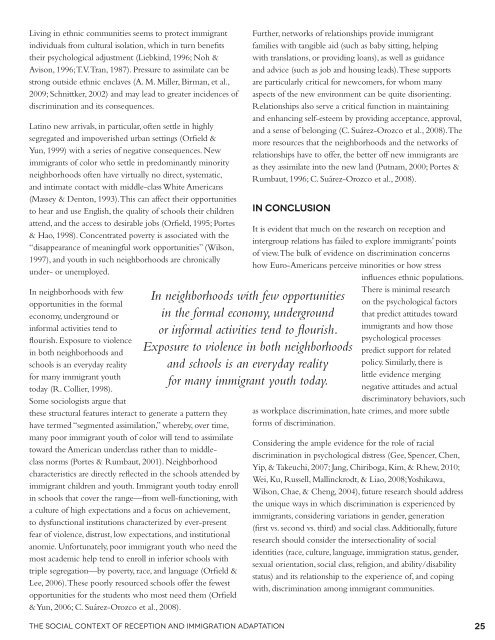Crossroads: The Psychology of Immigration in the New Century
Crossroads: The Psychology of Immigration in the New Century
Crossroads: The Psychology of Immigration in the New Century
Create successful ePaper yourself
Turn your PDF publications into a flip-book with our unique Google optimized e-Paper software.
Liv<strong>in</strong>g <strong>in</strong> ethnic communities seems to protect immigrant<br />
<strong>in</strong>dividuals from cultural isolation, which <strong>in</strong> turn benefits<br />
<strong>the</strong>ir psychological adjustment (Liebk<strong>in</strong>d, 1996; Noh &<br />
Avison, 1996; T. V. Tran, 1987). Pressure to assimilate can be<br />
strong outside ethnic enclaves (A. M. Miller, Birman, et al.,<br />
2009; Schnittker, 2002) and may lead to greater <strong>in</strong>cidences <strong>of</strong><br />
discrim<strong>in</strong>ation and its consequences.<br />
Lat<strong>in</strong>o new arrivals, <strong>in</strong> particular, <strong>of</strong>ten settle <strong>in</strong> highly<br />
segregated and impoverished urban sett<strong>in</strong>gs (Orfield &<br />
Yun, 1999) with a series <strong>of</strong> negative consequences. <strong>New</strong><br />
immigrants <strong>of</strong> color who settle <strong>in</strong> predom<strong>in</strong>antly m<strong>in</strong>ority<br />
neighborhoods <strong>of</strong>ten have virtually no direct, systematic,<br />
and <strong>in</strong>timate contact with middle-class White Americans<br />
(Massey & Denton, 1993). This can affect <strong>the</strong>ir opportunities<br />
to hear and use English, <strong>the</strong> quality <strong>of</strong> schools <strong>the</strong>ir children<br />
attend, and <strong>the</strong> access to desirable jobs (Orfield, 1995; Portes<br />
& Hao, 1998). Concentrated poverty is associated with <strong>the</strong><br />
“disappearance <strong>of</strong> mean<strong>in</strong>gful work opportunities” (Wilson,<br />
1997), and youth <strong>in</strong> such neighborhoods are chronically<br />
under- or unemployed.<br />
In neighborhoods with few<br />
opportunities <strong>in</strong> <strong>the</strong> formal<br />
economy, underground or<br />
<strong>in</strong>formal activities tend to<br />
flourish. Exposure to violence<br />
<strong>in</strong> both neighborhoods and<br />
schools is an everyday reality<br />
for many immigrant youth<br />
today (R. Collier, 1998).<br />
Some sociologists argue that<br />
<strong>the</strong>se structural features <strong>in</strong>teract to generate a pattern <strong>the</strong>y<br />
have termed “segmented assimilation,” whereby, over time,<br />
many poor immigrant youth <strong>of</strong> color will tend to assimilate<br />
toward <strong>the</strong> American underclass ra<strong>the</strong>r than to middleclass<br />
norms (Portes & Rumbaut, 2001). Neighborhood<br />
characteristics are directly reflected <strong>in</strong> <strong>the</strong> schools attended by<br />
immigrant children and youth. Immigrant youth today enroll<br />
<strong>in</strong> schools that cover <strong>the</strong> range—from well-function<strong>in</strong>g, with<br />
a culture <strong>of</strong> high expectations and a focus on achievement,<br />
to dysfunctional <strong>in</strong>stitutions characterized by ever-present<br />
fear <strong>of</strong> violence, distrust, low expectations, and <strong>in</strong>stitutional<br />
anomie. Unfortunately, poor immigrant youth who need <strong>the</strong><br />
most academic help tend to enroll <strong>in</strong> <strong>in</strong>ferior schools with<br />
triple segregation—by poverty, race, and language (Orfield &<br />
Lee, 2006). <strong>The</strong>se poorly resourced schools <strong>of</strong>fer <strong>the</strong> fewest<br />
opportunities for <strong>the</strong> students who most need <strong>the</strong>m (Orfield<br />
& Yun, 2006; C. Suárez-Orozco et al., 2008).<br />
<strong>The</strong> Social Context <strong>of</strong> Reception and ImmigraTION Adaptation<br />
Fur<strong>the</strong>r, networks <strong>of</strong> relationships provide immigrant<br />
families with tangible aid (such as baby sitt<strong>in</strong>g, help<strong>in</strong>g<br />
with translations, or provid<strong>in</strong>g loans), as well as guidance<br />
and advice (such as job and hous<strong>in</strong>g leads). <strong>The</strong>se supports<br />
are particularly critical for newcomers, for whom many<br />
aspects <strong>of</strong> <strong>the</strong> new environment can be quite disorient<strong>in</strong>g.<br />
Relationships also serve a critical function <strong>in</strong> ma<strong>in</strong>ta<strong>in</strong><strong>in</strong>g<br />
and enhanc<strong>in</strong>g self-esteem by provid<strong>in</strong>g acceptance, approval,<br />
and a sense <strong>of</strong> belong<strong>in</strong>g (C. Suárez-Orozco et al., 2008). <strong>The</strong><br />
more resources that <strong>the</strong> neighborhoods and <strong>the</strong> networks <strong>of</strong><br />
relationships have to <strong>of</strong>fer, <strong>the</strong> better <strong>of</strong>f new immigrants are<br />
as <strong>the</strong>y assimilate <strong>in</strong>to <strong>the</strong> new land (Putnam, 2000; Portes &<br />
Rumbaut, 1996; C. Suárez-Orozco et al., 2008).<br />
In Conclusion<br />
In neighborhoods with few opportunities<br />
<strong>in</strong> <strong>the</strong> formal economy, underground<br />
or <strong>in</strong>formal activities tend to flourish.<br />
Exposure to violence <strong>in</strong> both neighborhoods<br />
and schools is an everyday reality<br />
for many immigrant youth today.<br />
It is evident that much on <strong>the</strong> research on reception and<br />
<strong>in</strong>tergroup relations has failed to explore immigrants’ po<strong>in</strong>ts<br />
<strong>of</strong> view. <strong>The</strong> bulk <strong>of</strong> evidence on discrim<strong>in</strong>ation concerns<br />
how Euro-Americans perceive m<strong>in</strong>orities or how stress<br />
<strong>in</strong>fluences ethnic populations.<br />
<strong>The</strong>re is m<strong>in</strong>imal research<br />
on <strong>the</strong> psychological factors<br />
that predict attitudes toward<br />
immigrants and how those<br />
psychological processes<br />
predict support for related<br />
policy. Similarly, <strong>the</strong>re is<br />
little evidence merg<strong>in</strong>g<br />
negative attitudes and actual<br />
discrim<strong>in</strong>atory behaviors, such<br />
as workplace discrim<strong>in</strong>ation, hate crimes, and more subtle<br />
forms <strong>of</strong> discrim<strong>in</strong>ation.<br />
Consider<strong>in</strong>g <strong>the</strong> ample evidence for <strong>the</strong> role <strong>of</strong> racial<br />
discrim<strong>in</strong>ation <strong>in</strong> psychological distress (Gee, Spencer, Chen,<br />
Yip, & Takeuchi, 2007; Jang, Chiriboga, Kim, & Rhew, 2010;<br />
Wei, Ku, Russell, Mall<strong>in</strong>ckrodt, & Liao, 2008; Yoshikawa,<br />
Wilson, Chae, & Cheng, 2004), future research should address<br />
<strong>the</strong> unique ways <strong>in</strong> which discrim<strong>in</strong>ation is experienced by<br />
immigrants, consider<strong>in</strong>g variations <strong>in</strong> gender, generation<br />
(first vs. second vs. third) and social class. Additionally, future<br />
research should consider <strong>the</strong> <strong>in</strong>tersectionality <strong>of</strong> social<br />
identities (race, culture, language, immigration status, gender,<br />
sexual orientation, social class, religion, and ability/disability<br />
status) and its relationship to <strong>the</strong> experience <strong>of</strong>, and cop<strong>in</strong>g<br />
with, discrim<strong>in</strong>ation among immigrant communities.<br />
25
















